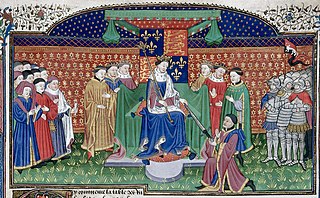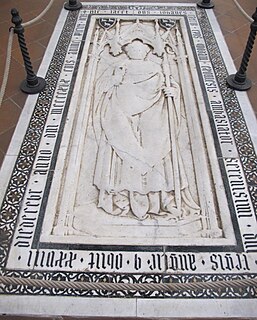Related Research Articles
Simon de Langham was an English clergyman who was Archbishop of Canterbury and a cardinal.

John Stafford was a medieval English prelate and statesman who served as Lord Chancellor (1432–1450) and as Archbishop of Canterbury (1443–1452).
Marmaduke Lumley was an English priest, Bishop of Carlisle from 1429 to 1450, and Knight Commander of the Order of St. John of Jerusalem. He was a son of Ralph de Lumley, 1st Baron Lumley and Eleanor de Neville. He was elected about 5 December 1429, and consecrated on 16 April 1430. He was Bishop of Lincoln for a short time before his death in December 1450. He was educated at University of Cambridge and was appointed Precentor of Lincoln Cathedral in 1425. He also became Chancellor of the University of Cambridge in 1427 and was Master of Trinity Hall, Cambridge from 1429 to 1443. From 1446 to 1449 he served as Lord High Treasurer of England. Lumley's tenure as Lord High Treasurer occurred during the Great Bullion Famine and the Great Slump in England.

Eata, also known as Eata of Lindisfarne, was Bishop of Hexham from 678 until 681, and of then Bishop of Lindisfarne from before 681 until 685. He then was translated back to Hexham where he served until his death in 685 or 686. He was the first native of Northumbria to occupy the bishopric of Lindisfarne.
Trumbert was a monk of Jarrow, a disciple of Chad and later Bishop of Hexham.
Eadberht of Selsey was an abbot of Selsey Abbey, later promoted to become the first Bishop of Selsey. He was consecrated sometime between 709 and 716, and died between 716 and 731. Wilfrid has occasionally been regarded as a previous bishop of the South Saxons, but this is an insertion of his name into the episcopal lists by later medieval writers, and Wilfrid was not considered the bishop during his lifetime or Bede's.

Alcmund of Hexham became the 7th bishop of the see of Hexham in Northumberland when he was consecrated on 24 April 767; the see was centred on the church there founded by Wilfrid.
Wilfrid (II) or Wilfrith (II) also known as Wilfrid the Younger, was the last Bishop of York, as the see was converted to an archbishopric during the time of his successor. In the 10th century, two different groups claim to have taken the relics of an earlier Wilfrid from Ripon; most likely one party took those of Wilfrid the Younger. The younger Wilfrid's feast is attested in the Calendar of Winchcombe and later martyrologies, though he does not seem to have had a widespread or popular veneration.

The Archbishop of York is a senior bishop in the Church of England, second only to the archbishop of Canterbury. The archbishop is the diocesan bishop of the Diocese of York and the metropolitan bishop of the Province of York, which covers the northern regions of England as well as the Isle of Man. The archbishop of York is an ex officio member of the House of Lords and is styled Primate of England; the archbishop of Canterbury is the "Primate of All England".
Thomas Brunce was a 15th-century Bishop of Rochester and then Bishop of Norwich.
John Fordham was Bishop of Durham and Bishop of Ely.

John Barnet was a Bishop of Worcester then Bishop of Bath and Wells then finally Bishop of Ely.
Nicholas Bubwith (1355-1424) was a Bishop of London, Bishop of Salisbury and Bishop of Bath and Wells as well as Lord Privy Seal and Lord High Treasurer of England.

John Catterick was a medieval Bishop of St David's, Bishop of Coventry and Lichfield, and Bishop of Exeter.

Richard Redman was a medieval Premonstratensian canon and abbot of Shap Abbey, Bishop of St Asaph, Bishop of Exeter, and Bishop of Ely, as well as the commissary-general for the Abbot of Prémontré between 1459 and his death.

Eadhæd was a medieval Bishop of Lindsey and sole Bishop of Ripon in the Medieval era.
Richard de Wentworth was a medieval Bishop of London.
Thomas Hemenhale was a medieval Bishop of Norwich-elect and then Bishop of Worcester.

Richard FitzJames was a medieval Bishop of Rochester, Bishop of Chichester and Bishop of London.
Eadmund was a 9th-century Englishman. It had been thought he had been Bishop of Winchester between 833 and 838. However, following further studies he is no longer listed to have been bishop.
References
- Fryde, E. B.; Greenway, D. E.; Porter, S.; Roy, I. (1996). Handbook of British Chronology (Third revised ed.). Cambridge: Cambridge University Press. ISBN 0-521-56350-X.